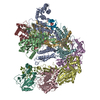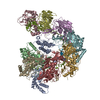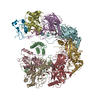[English] 日本語
 Yorodumi
Yorodumi- EMDB-21517: Cryo-EM structure of anti-CRISPR AcrIF9 and dsDNA, bound to the t... -
+ Open data
Open data
- Basic information
Basic information
| Entry | Database: EMDB / ID: EMD-21517 | ||||||||||||
|---|---|---|---|---|---|---|---|---|---|---|---|---|---|
| Title | Cryo-EM structure of anti-CRISPR AcrIF9 and dsDNA, bound to the type I-F crRNA-guided CRISPR surveillance complex | ||||||||||||
 Map data Map data | |||||||||||||
 Sample Sample |
| ||||||||||||
| Function / homology |  Function and homology information Function and homology informationmaintenance of CRISPR repeat elements / endonuclease activity / defense response to virus / Hydrolases; Acting on ester bonds / RNA binding Similarity search - Function | ||||||||||||
| Biological species |   Proteus penneri (bacteria) Proteus penneri (bacteria) | ||||||||||||
| Method | single particle reconstruction / cryo EM / Resolution: 4.2 Å | ||||||||||||
 Authors Authors | Hirschi M / Santiago-Frangos A / Wilkinson R / Golden SM / Wiedenheft B / Lander GC | ||||||||||||
| Funding support |  United States, 3 items United States, 3 items
| ||||||||||||
 Citation Citation |  Journal: Nat Commun / Year: 2020 Journal: Nat Commun / Year: 2020Title: AcrIF9 tethers non-sequence specific dsDNA to the CRISPR RNA-guided surveillance complex. Authors: Marscha Hirschi / Wang-Ting Lu / Andrew Santiago-Frangos / Royce Wilkinson / Sarah M Golden / Alan R Davidson / Gabriel C Lander / Blake Wiedenheft /   Abstract: Bacteria have evolved sophisticated adaptive immune systems, called CRISPR-Cas, that provide sequence-specific protection against phage infection. In turn, phages have evolved a broad spectrum of ...Bacteria have evolved sophisticated adaptive immune systems, called CRISPR-Cas, that provide sequence-specific protection against phage infection. In turn, phages have evolved a broad spectrum of anti-CRISPRs that suppress these immune systems. Here we report structures of anti-CRISPR protein IF9 (AcrIF9) in complex with the type I-F CRISPR RNA-guided surveillance complex (Csy). In addition to sterically blocking the hybridization of complementary dsDNA to the CRISPR RNA, our results show that AcrIF9 binding also promotes non-sequence-specific engagement with dsDNA, potentially sequestering the complex from target DNA. These findings highlight the versatility of anti-CRISPR mechanisms utilized by phages to suppress CRISPR-mediated immune systems. | ||||||||||||
| History |
|
- Structure visualization
Structure visualization
| Movie |
 Movie viewer Movie viewer |
|---|---|
| Structure viewer | EM map:  SurfView SurfView Molmil Molmil Jmol/JSmol Jmol/JSmol |
| Supplemental images |
- Downloads & links
Downloads & links
-EMDB archive
| Map data |  emd_21517.map.gz emd_21517.map.gz | 25.1 MB |  EMDB map data format EMDB map data format | |
|---|---|---|---|---|
| Header (meta data) |  emd-21517-v30.xml emd-21517-v30.xml emd-21517.xml emd-21517.xml | 19 KB 19 KB | Display Display |  EMDB header EMDB header |
| Images |  emd_21517.png emd_21517.png | 72.5 KB | ||
| Archive directory |  http://ftp.pdbj.org/pub/emdb/structures/EMD-21517 http://ftp.pdbj.org/pub/emdb/structures/EMD-21517 ftp://ftp.pdbj.org/pub/emdb/structures/EMD-21517 ftp://ftp.pdbj.org/pub/emdb/structures/EMD-21517 | HTTPS FTP |
-Validation report
| Summary document |  emd_21517_validation.pdf.gz emd_21517_validation.pdf.gz | 377.1 KB | Display |  EMDB validaton report EMDB validaton report |
|---|---|---|---|---|
| Full document |  emd_21517_full_validation.pdf.gz emd_21517_full_validation.pdf.gz | 376.7 KB | Display | |
| Data in XML |  emd_21517_validation.xml.gz emd_21517_validation.xml.gz | 5.5 KB | Display | |
| Arichive directory |  https://ftp.pdbj.org/pub/emdb/validation_reports/EMD-21517 https://ftp.pdbj.org/pub/emdb/validation_reports/EMD-21517 ftp://ftp.pdbj.org/pub/emdb/validation_reports/EMD-21517 ftp://ftp.pdbj.org/pub/emdb/validation_reports/EMD-21517 | HTTPS FTP |
-Related structure data
| Related structure data |  6whiMC  6w1xC C: citing same article ( M: atomic model generated by this map |
|---|---|
| Similar structure data |
- Links
Links
| EMDB pages |  EMDB (EBI/PDBe) / EMDB (EBI/PDBe) /  EMDataResource EMDataResource |
|---|
- Map
Map
| File |  Download / File: emd_21517.map.gz / Format: CCP4 / Size: 27 MB / Type: IMAGE STORED AS FLOATING POINT NUMBER (4 BYTES) Download / File: emd_21517.map.gz / Format: CCP4 / Size: 27 MB / Type: IMAGE STORED AS FLOATING POINT NUMBER (4 BYTES) | ||||||||||||||||||||||||||||||||||||||||||||||||||||||||||||
|---|---|---|---|---|---|---|---|---|---|---|---|---|---|---|---|---|---|---|---|---|---|---|---|---|---|---|---|---|---|---|---|---|---|---|---|---|---|---|---|---|---|---|---|---|---|---|---|---|---|---|---|---|---|---|---|---|---|---|---|---|---|
| Projections & slices | Image control
Images are generated by Spider. | ||||||||||||||||||||||||||||||||||||||||||||||||||||||||||||
| Voxel size | X=Y=Z: 1.15 Å | ||||||||||||||||||||||||||||||||||||||||||||||||||||||||||||
| Density |
| ||||||||||||||||||||||||||||||||||||||||||||||||||||||||||||
| Symmetry | Space group: 1 | ||||||||||||||||||||||||||||||||||||||||||||||||||||||||||||
| Details | EMDB XML:
CCP4 map header:
| ||||||||||||||||||||||||||||||||||||||||||||||||||||||||||||
-Supplemental data
- Sample components
Sample components
+Entire : Anti-CRISPR AcrIF9 bound to the type I-F crRNA-guided CRISPR surv...
+Supramolecule #1: Anti-CRISPR AcrIF9 bound to the type I-F crRNA-guided CRISPR surv...
+Supramolecule #2: type I-F crRNA-guided CRISPR surveillance complex
+Supramolecule #3: Anti-CRISPR AcrIF9
+Macromolecule #1: CRISPR-associated protein Csy1
+Macromolecule #2: Type I-F CRISPR-associated protein Csy2
+Macromolecule #3: CRISPR-associated protein Csy3
+Macromolecule #4: RNA (60-MER)
+Macromolecule #5: CRISPR-associated endonuclease Cas6/Csy4
+Macromolecule #6: anti-CRISPR AcrIF9
+Macromolecule #7: non-target dsDNA
+Macromolecule #8: non-target dsDNA
-Experimental details
-Structure determination
| Method | cryo EM |
|---|---|
 Processing Processing | single particle reconstruction |
| Aggregation state | particle |
- Sample preparation
Sample preparation
| Buffer | pH: 7.5 |
|---|---|
| Grid | Details: unspecified |
| Vitrification | Cryogen name: ETHANE |
- Electron microscopy
Electron microscopy
| Microscope | FEI TALOS ARCTICA |
|---|---|
| Image recording | Film or detector model: GATAN K2 SUMMIT (4k x 4k) / Detector mode: COUNTING / Number real images: 6472 / Average exposure time: 11.5 sec. / Average electron dose: 66.0 e/Å2 |
| Electron beam | Acceleration voltage: 200 kV / Electron source:  FIELD EMISSION GUN FIELD EMISSION GUN |
| Electron optics | C2 aperture diameter: 100.0 µm / Illumination mode: FLOOD BEAM / Imaging mode: BRIGHT FIELD / Cs: 2.7 mm / Nominal defocus max: 1.2 µm / Nominal defocus min: 0.8 µm / Nominal magnification: 36000 |
| Sample stage | Cooling holder cryogen: NITROGEN |
| Experimental equipment |  Model: Talos Arctica / Image courtesy: FEI Company |
- Image processing
Image processing
| Particle selection | Number selected: 1049173 |
|---|---|
| Final reconstruction | Applied symmetry - Point group: C1 (asymmetric) / Resolution.type: BY AUTHOR / Resolution: 4.2 Å / Resolution method: FSC 0.143 CUT-OFF / Software - Name: RELION (ver. 3.1) / Number images used: 152066 |
| Initial angle assignment | Type: MAXIMUM LIKELIHOOD |
| Final angle assignment | Type: MAXIMUM LIKELIHOOD |
 Movie
Movie Controller
Controller











 Z (Sec.)
Z (Sec.) Y (Row.)
Y (Row.) X (Col.)
X (Col.)





















